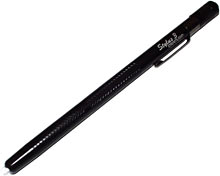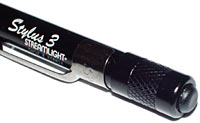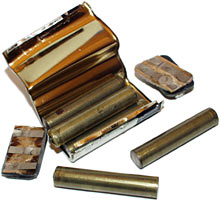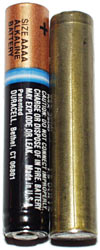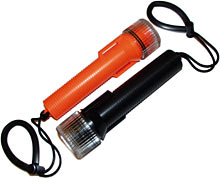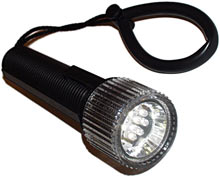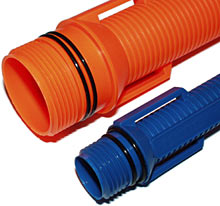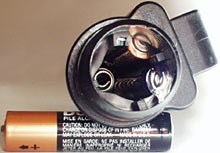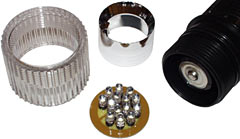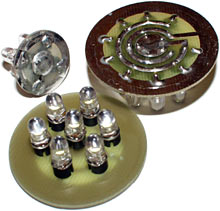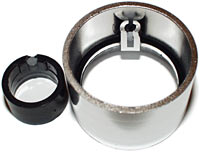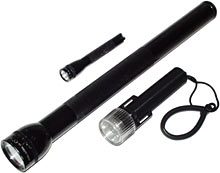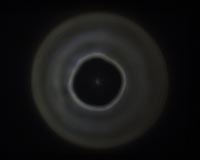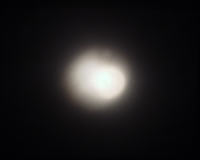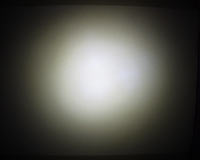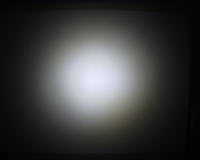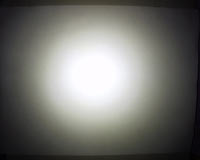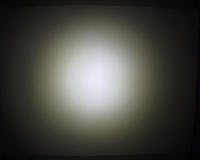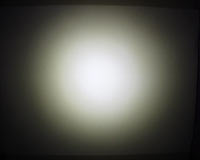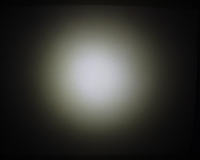
LED flashlight roundup - part 2!
Review date: 9 June 2001.Last modified 03-Dec-2011.
After I did my last LED flashlight comparison, I received a few more of these high-tech illumination gadgets for review.
From serious-flashlight specialists Streamlight came this, the Stylus 3. It's a single-LED unit that's a lot more like a pen than most "penlights".
From Tektite came this little lot - a selection of their heavy duty three-cell flashlights. This collection have batteries ranging from AAA to C size, and come with two, four, seven or an impressive 14 LEDs.
But first - the Stylus.
Flashlight d'elegance
The Streamlight Stylus 3 is not a big chunky macho flashlight. It does not have a mighty fog-penetrating beam. It would not be much use to you in a fight.
What it is, rather, is the neatest penlight I've ever seen. Not to mention the only flashlight I've ever owned that has its own serial number.
The Stylus' aluminium body isn't even a centimetre thick, and it's not quite 17 centimetres long. So it's genuinely pen sized; it's only about an inch longer than the average pen.
The reflectorless LED at the business end of the Stylus is the narrowest point of the light, so you can use it as an inspection light - poking it through holes and into cracks and the like - without the body of the light getting in the way of your view.
Streamlight's suggested retail price for this, the white LED version of the Stylus, is $US21.95. Which is pretty cheap by LED light standards. There are orange, red, blue and green LED versions as well And an infra-red model, which may come in handy for those among us whose hobbies include telling something to put the lotion in the basket or it'll get the hose again.
The complete Streamlight price list is here.
The Stylus 3's switch is at the end of the light. It's a simple ring-contact design that lets you press the button on the end of the light for momentary operation, or just tighten the cap down to turn it on constantly. Unscrew the end cap and you can get at the batteries.
Which are a little odd.
These are AAAA (quadruple-A, aka LR61, AM6 or E96) cells, shown here with a standard AA for scale. They're a little shorter than a AAA cell, but considerably narrower.
You don't have to worry about your first set of AAAAs - they're included with the Stylus. But getting your next set could be a little challenging.
My first thought was that the good thing about this power source is that no matter whether you're at the bottom of a five-mile cave system, performing extra-vehicular activity on the International Space Station, or lost in the middle of the Gobi Desert, you at least know you're no further away from a place that sells AAAA cells than you'd be if you were standing in your local shopping centre.
Needless to say, it actually turned out to be pretty easy to find the things. Battery specialists like Batteries Australia Online stock them; the price from that site is $AU4.50 per cell (versus $AU44 for a box of forty AAA alkalines...), but it's not as if the Stylus is going to eat ten cells a week.
The 550mAh capacity of a AAAA alkaline ought to last a long time, with occasional use. I make a stab at figuring out how long in the "Power Consumption" section below.
It's a tad annoying that this thing uses three AAAAs, when they are of course normally provided in pairs. Such is life.
Update - cheap AAAAs!
A couple of readers clued me in on where to find AAAA cells - well, cells that are near enough to AAAA size as to make no difference, anyway - without paying a fortune for them.
Nine volt batteries.
The word "battery", applied to electrochemical devices, indicates a thing with more than one discrete cell inside it. They might be physically connected, but they're electrochemically separate. Using multiple cells lets you take an electrochemical reaction that makes, say, 1.5 volts - which is the potential per cell of household "batteries" - and multiply the voltage by however many cells you use.
Six volt lantern batteries have four 1.5V cells in them. Nine volt batteries have six 1.5V cells. And all of the common 1.5 volt "batteries" are really just single cells of different sizes.
Cheaper 9V batteries are made out of little rectangular cells wrapped in waxed paper. They're of little interest.
Better 9V batteries are made out of six cylindrical near-AAAA-sized cells.
Here's an Energizer 9V, peeled like an orange. It's not too hard to lever the crimped case open, using a small screwdriver.
The six cells are loose, once you remove the case and the separate end pieces with the inter-cell connectors on them. The cells then just fall out.
Given the quoted capacity of 9V batteries, these AAAAs seem to be pretty much exactly the same, electrically speaking, as "real" ones.
Unfortunately, AAAAs from a 9V battery - well, from this 9V battery, anyway - aren't quite as long as real AAAAs. The width is perfect, and they've got plastic sleeving that means they won't short out, and they've got nipples on the ends for good contact. But if you put three of them in the Stylus, they rattle back and forth and don't make contact.
This is far from an insurmountable problem. You can't stretch the Stylus' cap contact spring enough to make up for the shorter cells, but you could easily knock together an extra spring with proper sleeving - say, a spring from a ballpoint pen, with a bit of spaghetti tubing around it - to make up the shortfall. You wouldn't need much.
Apparently, Duracell alkaline 9V batteries have slightly longer cells in them, so you can make them work in the Stylus by just (carefully) stretching the cap contact spring. The management assumes no responsibility for broken springs.
Stylus light
The Stylus' light output is a noticeably blue-tinged white, with the super-smooth drop-off from the central light pool that's characteristic of high intensity white LEDs. In the brightness comparison below, it unsurprisingly loses to the multi-LED Tektite flashlights, but it can mix it perfectly well with any incandescent-globe penlight.
For the money, of course, you'd blooming want the Stylus 3 to be rather nice. It's comfortably twice the price of a two-AAA-cell Mini Maglite, and you can get a basic two-AA-cell penlight, with similar light output, from the supermarket for a few bucks.
But this penlight's got a bulb that lasts forever. LEDs generally have tens of thousands of hours of life, so burnout's unlikely to be a problem; physically, I don't know how many times you could drop the Stylus 3 on its nose onto a concrete floor, but you'd probably be surprised. And the Stylus is just nice to use; it feels like a top-class product. If James Bond needs a penlight, this is the one he'll use.
If you want more light, though, you need more LEDs. Which is where Tektite come in.
Plastic power
Tektite, like Streamlight, are not an LED flashlight company. They make conventional filament-globe flashlights in various shapes and sizes, and now have a popular sideline in LED models as well.
Tektite's LED flashlights use the same bodies as some of their incandescent products, but with a multi-LED lamp assembly in place of the normal globe.
There are quite a lot of these sorts of "retrofit" LED flashlight designs. Many of them don't actually work particularly well. Typically, retrofit flashlights give you one or two weedy LEDs, surrounded by a reflector that now does nothing much because the LEDs already have a lens moulded around their light-emitting core. Frequently, those couple of LEDs are backed by big batteries that give you monster run time, but with disappointing light output, considering the size of the flashlight.
White LEDs are only about as efficient as halogen incandescent globes. A flashlight that has one white LED running from, say, three D cells, will thus probably have something like a 200 hour run time - and probably plenty more at reduced output. But it'll only ever have the light output of a penlight.
Tektite's LED lights are not like this. The lamp assembly's made to suit the LEDs, the battery capacity's quite well suited to the lamp power, and the whole package is quite pleasing to use.
These are the basic Tektites, the Trek 2 and Trek 4. They're named for the number of LEDs they have, they both run from three AA cells (which are included), and they list for $US34.95 and $US44.95, respectively.
The colour of the light doesn't correspond to anything; the lamp and body assemblies are interchangeable, and all of the Tektite lights are available in a variety of colours. Including pink, by the way. I noticed that picking slip for my review lights specified "no pink", to make sure the warehouse guys didn't send me an effeminate-looking flashlight.
The Trek lights both have a simple elastic lanyard on the tail loop of their super-tough ABS (which, in case you care, stands for "Acrylonitrile Butadiene Styrene") plastic body. There are two moulded-in slots on the side, too, so you can easily attach the torch in a rather permanent way to a belt or webbing or what have you.
All of the Tektite lights have a simple twist-the-end switch design, and they go together like most plastic flashlights - you unscrew the lamp/switch to get at the battery bay.
The screw-on polycarbonate lens of each of the Treks comes with a removable rubber protector. The rubber's not really there to stop the lens from being damaged; polycarbonate's very tough. Rather, it stops the flashlight from throwing annoying light out sideways at the user's eyes; it's a glare shield. Not a great deal of light actually escapes that way, though, and if you want your flashlight to be more visible, you can just slide the rubber off.
These bigger Tektite lights are the Expedition 300 - the orange one - and the Expedition 1400 - the black one. The 300 has seven LEDs and lists for $US69.95; the 1400 has no fewer than 14 LEDs and costs an impressive $US119.95.
The Expeditions have belt slots on the side, like the Treks. They've got lanyards, too, but now they're made of nylon cord with a piece of rubber tubing around the middle bit for padding and a spring-loaded slide-woggle thingy that lets you easily affix them to the average, or much larger than average, wrist.
The C-cell Tektites have looser battery mounting than the AA-cell models, and the batteries can rattle around a bit. This does no harm, but if you're a professional assassin, or something, you'll probably want to muffle the cells with a bit of foam.
All of these C and AA cell Tektite lights are proper dive lights, with twin-O-ring seals.
These seals - which you can keep in good condition with an occasional squirt of silicone spray - make these flashlights seriously waterproof, with a 1000 foot rating. They're proper dive lights, in other words. The twist-switch design means they can easily be turned on and off under great pressure; many dive lights use this kind of switch, and most of the rest use a slide switch. Normal pushbuttons are no good for anything beyond quite shallow water, as the pressure will permanently push the switch for you.
Confusingly, Tektite also make slightly cheaper versions of some of their flashlights, with only a single O-ring. They're still waterproof as far as most users are concerned, but no longer qualify as a dive light. The Expedition 1400 (and the even brighter 19-LED Expedition 1900, which I didn't get for review) only come in twin-O-ring versions, but all of the other AA and C cell lights are made in both flavours.
Some of the Trek lights sold on the C. Crane site - which is the official "retail site" linked to by Tektite themselves - are the single-O-ring version; if that's not what you want, get the "Dive Version" instead. The difference doesn't matter for most users, but it does for divers.
Here's a Tektite light which, mercifully, comes in only one version.
The Mini-Trek is a very compact 2-LED flashlight powered by three AAA cells. It's got a single O-ring - so it's not a dive light - but apart from that, it's a wee ripper.
At a glance, the $US34.95 Mini-Trek looks like some sort of weapon light - those "tactical illuminators" that humourless people with dark coloured uniforms attach to guns. It's not one of those, but it does have a handy moulded-in clip on the side, which lets you attach it to your belt
There's also a "bite tab" on the back of the Mini-Trek, for hands-free use. And it comes with the same rubber lens protector thingy as the AA-cell Treks.
The three AA cells in the Mini-Trek are packed in a triangle in this cunningly designed battery bay. To get batteries into or out of this flashlight, you have to prod and push them with a screwdriver. It's actually pretty easy to do after a brief learning curve, but it's not something you can do with your bare hands, and also not something I'd care to have to do in pitch blackness.
The slightly awkward battery arrangement, though, allows this flashlight to be only about ten centimetres long. It's practically palm sized, it fits in a pocket, and it's got decent light output, as we'll see.
All of the Trek lights have a lamp-and-lens assembly that works in much the same way. This is the end of the Expedition 1400, but the others are similar.
Under the lens, there's a plastic ring whose main purpose is to allow the lens to push the round lamp circuit board down when you tighten the thread. Push it down far enough and the edge of the circuit board touches the negative contact coming from the other end of the flashlight. The middle of the circuit board constantly touches the positive contact of the top battery, and that's how the switch works.
The push-rings on the Expedition flashlights are silvered, and their faceted top edges reflect a bit of light forward. The ones on the smaller lights are plain black.
Because the lamp assemblies all use the same centre-positive, edge-negative design, the ones with more LEDs have to have a more complex layout. The Trek 4 lamp at top left is simple enough, but the Expedition 1400 one, upside down at the top of the picture, is quite elaborate.
The reflector-rings also each have a little grey pellet in a holder on the inside edge. That pellet is made of catalytic hydrogen absorbing stuff. It's there to stop your flashlight from exploding.
Sealed flashlights do that, sometimes.
The reason why they do that is that the batteries produce a small amount of hydrogen in normal use - flat or damaged batteries can, as they leak, release a lot more.
In most battery powered devices, that doesn't matter; the battery bay isn't sealed, and the hydrogen escapes. All you have to worry about if your batteries leak is cleaning up the electrolyte and dealing with corroded battery contacts.
In a sealed flashlight, though, the hydrogen has nowhere to go. If there's enough of it - bang.
The little grey pellet is there to absorb hydrogen, if there's hydrogen there to absorb. After a dead-batteries incident, you're meant to replace it.
Power consumption
The power consumption, and light output, of these lights isn't as straightforward as it might be. The kind of battery they use is a big factor.
The larger the load on a battery, the lower its terminal voltage will be. So if you've got three AA cells that each happen to read a perfect 1.5 volts (fresh batteries will actually have a bit more terminal voltage when they're not under load), and then you hook them up to something that sucks a significant amount of current out of them, their terminal voltage will fall. The smaller the cell, the more affected it is. For AAA cells, only 10 milliamps (mA) is a "typical drain" figure, above which you'll get significant voltage sag and less cell capacity. C cells can handle something like ten times as much current for a given voltage sag.
In a simple DC circuit like any of these flashlights, the voltage and current are interrelated - voltage equals current times the circuit resistance. At the instant when you turn a flashlight on, the batteries will deliver their full voltage, and that voltage will determine the current. That instantaneous current draw will practically immediately cause the voltage to fall, though, and then the current will fall as well. Over the first small fraction of a second after turn-on, the batteries will settle to an equilibrium voltage for whatever load they're under.
To test the AA-cell Tektite lamps, I set up three not-quite-brand-new AA cells, which still managed a healthy 1.48 volts per cell under no load. The two-LED lamp caused their voltage to sag to 3.9V, and the current draw was 98mA. That's 0.38 watts, which is quite a lot for two LEDs, but it's not amazing by LED flashlight standards. With quality alkalines, you ought to get more than 15 hours of continuous operation out of a set of batteries before you notice any brightness loss, and more than 20 hours of close-to-full light, and then quite a lot more - days, probably - before the batteries are really dead flat.
With adequate heat sinking, you can run LEDs at quite a lot more than the usual 20 to 30mA quoted on their spec sheets. The single LED in the aluminium-bodied LEDCorp flashlight I reviewed last time draws about 80mA by itself; by those standards, 49mA per LED for a twin-LED lamp isn't that ferocious.
The four-LED lamp assembly hit the AAs harder; now the voltage was 3.77V, but the current only rose to 125mA, for a 0.47 watt draw. That's only 31.25mA per LED, and bodes well for a very long lamp life - maybe even as long as the usually-quoted 100,000 hours, which is more than 11 straight years.
Higher current draw gives you more light, but less life. Slightly overdriven LEDs don't die suddenly like a filament globe, though; they just get dimmer faster than they otherwise would.
The four-LED Trek ought to give you considerably more than half the full-brightness battery life of the two-LED one. Ten to 15 hours wouldn't surprise me.
Now I switched to three fresh C cells, which managed about 1.57 volts per cell with no load. Connecting the 7-LED lamp assembly pulled the voltage down to 3.9V, and 340mA flowed. Less than 50mA per LED, but 1.33 watts in total.
The higher capacity, and current tolerance, of the C cells compared with the alkalines should give the Expedition 300 plenty of battery life. 20 to 30 hours, no worries, plus more days and days of better-than-nothing light after that.
The 14-LED lamp hauled the C cells down to 3.7 volts, and, again, the current didn't hop up by nearly as much as you might expect from just counting the LEDs. 430mA flowed, which is under 31mA per LED, and 1.59 watts. So the battery life ought not to suffer terribly; more than 20 hours should still be perfectly attainable.
LEDs running well above their rated current make more light, but not as much more light as you might think, if you just looked at the current draw. High output LED efficiency falls as current rises above 30mA or so. So the total power draw of the Expedition 1400 may not be about 19% higher than that of the Expedition 300, but it's using the power better - turning more of it into light, and less of it into useless heat. As we'll see in the output comparison below.
At the smaller end of the market, the three AAA cells in the Mini Trek were good for 1.52 volts each with no load. They sagged to a clean four volts under load, and 65mA flowed; a sensible current rating per LED, and a 0.26 watt power rating. The thing's specified as having 10 hours of full-brightness output; with modern higher-output AAA cells, that might be accurate, or a little optimistic. But, once again, the thing'll keep shining for quite a while on near-dead batteries; it won't dim to nothing over five minutes if you're using any kind of alkaline.
At the very small end of the market, the three tiny AAAA cells in the Stylus 3 managed about 4.575 volts with no load. I don't know what they sagged to under load - the design of the little flashlight made it practically impossible to hook test leads up to find out - but I could measure the current drawn by the single LED, which was 69mA. I'd bet on that working out at about a 0.25 to 0.26 watt power rating. If this light managed five straight hours of full-brightness output, I'd be surprised.
To show the differences between the LED lights and quality conventional torches, I threw two of my Maglites into the fray.
At the bottom, the Expedition 1400. At the top, a Mini Maglite. The Freudian behemoth in the middle is Mag Instrument's Club With A Bulb, the six-D-cell Special Police Brutality Edition.
The 2-AA-cell Mini Maglite is a hugely popular small flashlight with a remarkably bright "grain-of-wheat" bulb, which lasts pretty well, considering how hard its minuscule filament is working. With batteries, it sells for something like $US15, but if you use it all the time you'll be buying new $US1 bulbs regularly. There's a spare bulb in the tailcap, and that's a good thing.
The Mini Mag sucked a pair of fresh 1.585 volt AAs down to 2.55-odd volts between them, and drew more than 300mA. No wonder those little bulbs die so quickly - that's almost 0.8 watts!
The huge 6-D Maglite sells for something like $US35 without batteries, and uses a more normal-looking flange-fitting bulb with a quite respectable lifespan - though it's still nothing compared with an LED, of course.
The D cells in the big torch weren't even slightly new; they'd been sitting there for ages. But no way was I going to buy six new D cells for a filament-bulb torch when I'd just got another pile of LED lights for free, OK?
The old D cells managed only 8.8 volts in total, which is 1.47 volts each. That meant they were still far from flat, and they only sagged down to 7.45 volts with the torch turned on - 1.24 volts each. Current draw was an imposing 655mA, for 4.88 watts. From fresh batteries, this torch would do five watts easily.
The big Maglite, with its stock globe, is thus a pretty darn bright flashlight. It doesn't have anything like the light output of a high-end Surefire, but then neither does it have a monster price tag. Or, for that matter, excitable little lithium batteries with built-in thermal cutouts to stop them from catching fire.
Just how bright are all of these lights compared with each other, though?
Let's find out, shall we?
Light output
Time for pictures of a piece of white paper again.
These test shots, like the ones in my earlier comparison, were taken 40cm (15.75 inches) from the target, which was an A3 sheet of paper positioned with its long axis horizontal. The top and bottom edges of the sheet are just visible in the shots of the brighter flashlights' output; it's 297mm (11.7 inches) high.
I started with a 1/20th second exposure with my ISO 100 Olympus C-2500L digital camera, at its maximum wide angle, F2.8 setting, as in the previous comparisons. The brightness of the bigger flashlights, though, forced me to shorten the exposure to stop them burning out the middle of the image, as we'll see.
Here's the output from the Stylus. Distinctly blue, not tremendously bright. A good light level for a penlight, though; I can find my way around the house at night with the Stylus with no trouble at all. And as an inspection light, when the thing it's illuminating is usually only a few inches away from it, it's great.
For comparison, here's the wide-angle output from the fat aluminium-body single-LED LEDCorp flashlight from the last comparison. Focussed down to the same beam width as the Stylus, it has a similar light output.
And, for old-technology reference, here's the output from the Mini Maglite, at its narrowest beam setting, with two fresh-from-the-pack batteries and a slightly used bulb.
Here's the output from the Mini-Trek. Whiter than the Stylus - all of the Tek-Tite lights are a pretty straight white with a slight blue core, like most white LED flashlights. And, as you'd expect, it's also brighter than the Stylus.
The 2-LED Trek light, as it came out of the package. The LEDs aren't very well aligned, which is why the light has this binary-star look about it. That's actually fairly handy, if you ask me - an oval pool of light is quite useful in many situations.
I pinched the LEDs together with my fingers and the effect became less drastic, but there were still two definite lobes to the light.
The four-LED Trek. This one's LED alignment is fine, and its light output is respectable.
For comparison again, here's the output from a four-LED EternaLight, from the last comparison. The Trek light's noticeably brighter, even though its current draw is lower; the four-LED EternaLight runs from three cells, too, and it's a 0.57 watt device when it's going full blast. I presume the EternaLight LEDs are a bit less efficient, and no doubt its fancy microcontroller eats a little power as well.
On to the 7 LED Expedition. At 1/20 second, this light's getting a bit too bright for the camera. The middle of the frame's whiting out.
Dropping to a 1/40 second exposure halves the brightness, and gives a result that looks a bit dimmer than the 1/20 second exposure from the 4 LED Trek. Which reassures me that my camera does what it says it's doing.
This is the 14 LED Expedition at 1/40 second, lighting up the room with the reflected light from the target. Even at 1/40, this thing gives a white core to the light puddle.
So I dropped to 1/80. Now the big Expedition looks barely brighter than the Mini Trek at 1/20th - but it's being given only a quarter as much time to impress the image sensor.
Sticking with the 1/80th shutter speed, here's the output from the Stylus again. Now you can clearly see its blue tone, and you can also clearly see that this shot is pretty seriously underexposed. There is a very, very big difference in brightness between one LED and 14!
The Expedition 1400 is an impressively bright flashlight, and can certainly mix it with any 1.6 watt halogen-globe light - and with ordinary nitrogen-filled bulb torches with rather higher power ratings. But it ain't much compared with the giant Maglite.
This doesn't look much brighter than the Expedition 1400's output, does it?
Well, that's because this is a 1/160 second exposure.
When I used its narrowest beam setting, the big Maglite's roughly-five-watt globe just gave me a circle of maxed-out white in the middle of the frame even at 1/320, at this close range. So I twisted the reflector out to a partial flood beam. The maximum flood setting is a lot wider than this, though very uneven compared with LED light.
Even with the wider beam, I still needed a 1/160 second shutter speed to get something like proper exposure.
So even with its stock globe and somewhat tired D cells, the giant Maglite has comfortably double the light output of the Expedition 1400. It's drawing three times as much power, though.
As I may have mentioned already, the 6 cell Maglite is not a small torch. Walking past police officers with this thing may well result in a rather terse conversation concerning what, precisely, you're intending to do with it, and whether you'll be needing to hose it off afterwards. It is not competing with normal flashlights.
And quantity of light is just one thing. The LED lights, as you can see, do OK in that department, but they don't set any records.
The big deal about LEDs isn't that they give you a lot more light. It's that they give you better light.
It's difficult to express just how primitive most filament-bulb flashlights seem after you've been using white LED lights for a while.
OK, the 6 cell Maglite outshines all of the LED lights by a mile and costs a lot less than the Expeditions, but the thing's gigantic. And its output is uneven and yellow. My camera's auto white balance makes the Maglite light look white, and you'll think it is too if you're used to it. The human brain compensates well for colour casts in illumination.
But if you switch between LED and incandescent lights, it's very easy to see the advantage of the newer technology. Incandescents give you yellow, uneven, attenuated sunlight. White LEDs give you a smooth pool of instant lambent moonlight, baby.
Yes, I said "lambent".
Wanna make something of it?
Shortcomings
None of these flashlights has a brightness control. They're on, or they're off. That's it.
Not many flashlights do have a dimmer, of course. But the fancy microprocessor-controlled EternaLights I review in my last comparison and in my first LED flashlight review do. It's surprising how handy that feature is.
Brightness control lets you dial up a battery-saving low-brightness mode when you don't need, or want, lots of light. So you can preserve your night vision as you walk up to the white-painted back door and open it, then click on full-brightness mode to find out exactly where the cats are arguing in the yard.
None of the LED models in this comparison have a spot-beam mode, either. A tight beam's not actually very useful for many flashlight tasks, but it's a nice thing to have. And the only proper adjustable beam LED light I've seen so far is LEDCorp's groovy aluminium torch, reviewed last time.
The Expedition 1400 also has a design flaw. The hydrogen absorber holder in its switch-pressure ring can squish the LEDs. This can happen quite drastically if you put the ring in wrong, so that the holder doesn't line up with the gap in the LEDs provided to accept it. But it can also happen over several switch cycles, as the ring turns relative to the lamp board. The LEDs can be bent back into place, but I wouldn't like to have to do that many times. The LED leads or solder joints will give out eventually.
You can solve this problem by tacking the ring to the lamp circuit board with some kind of flexible glue, though.
Which to choose?
If you just want an ordinary common-or-garden flashlight for undemanding household purposes, the spectacular cheapness of a basic model from the supermarket is hard to argue against. If a popped bulb isn't going to result in any death or destruction, there's no reason to pay (at least) ten times more for the LED alternative.
If you want a flashlight that's pretty much guaranteed to work as long as its batteries live, though, these are all good.
The Stylus is super-elegant. The Mini-Trek is really convenient. The regular Treks are very tough and should get impressive battery life. The Expedition 300, although expensive, is brighter for the money than the similarly priced four-LED EternaLight models. And the Expedition 1400, although very expensive for its light power, does have enough power to be a worthwhile replacement for lower powered halogen dive lights. And proper dive lights aren't exactly dirt cheap anyway, and this one has zero chance of a scary bulb failure at an awkward moment.
I've been using all of these lights for a while now, and my favourites are the Expedition 1400 and the Mini-Trek. I wouldn't be so keen on the 1400 if I'd had to pay for it, but if you've got the money, you'll like it.
The Stylus is good for the toolbox - or the briefcase, or the pocket protector - but not bright enough for general purpose use. But it's well priced, by LED light standards.
There's really not one dud product here.
So pick one, and go and buy it.
You'll like it.
Streamlight Stylus 3 kindly provided by Streamlight
Tektite flashlights kindly provided by Tektite
